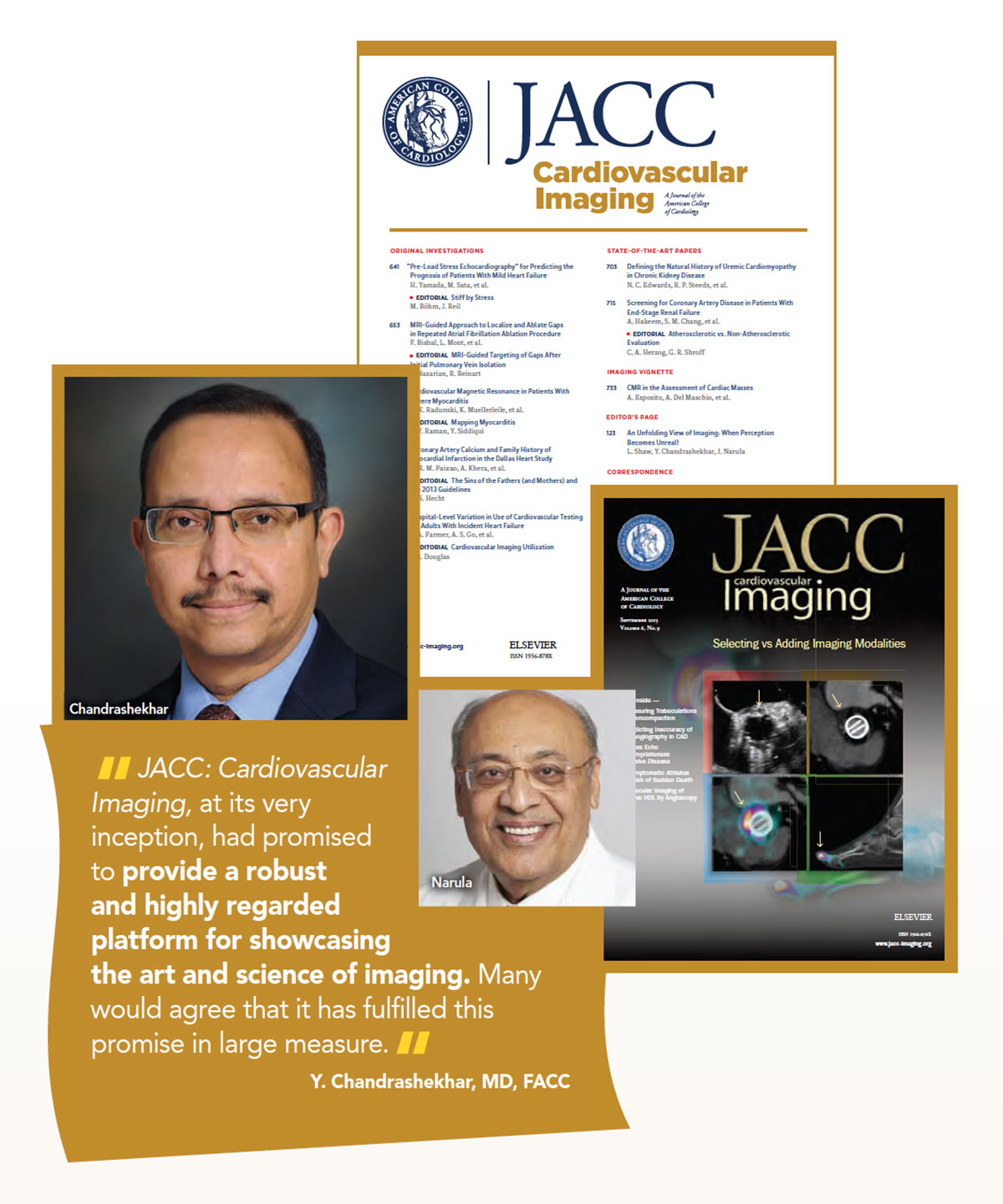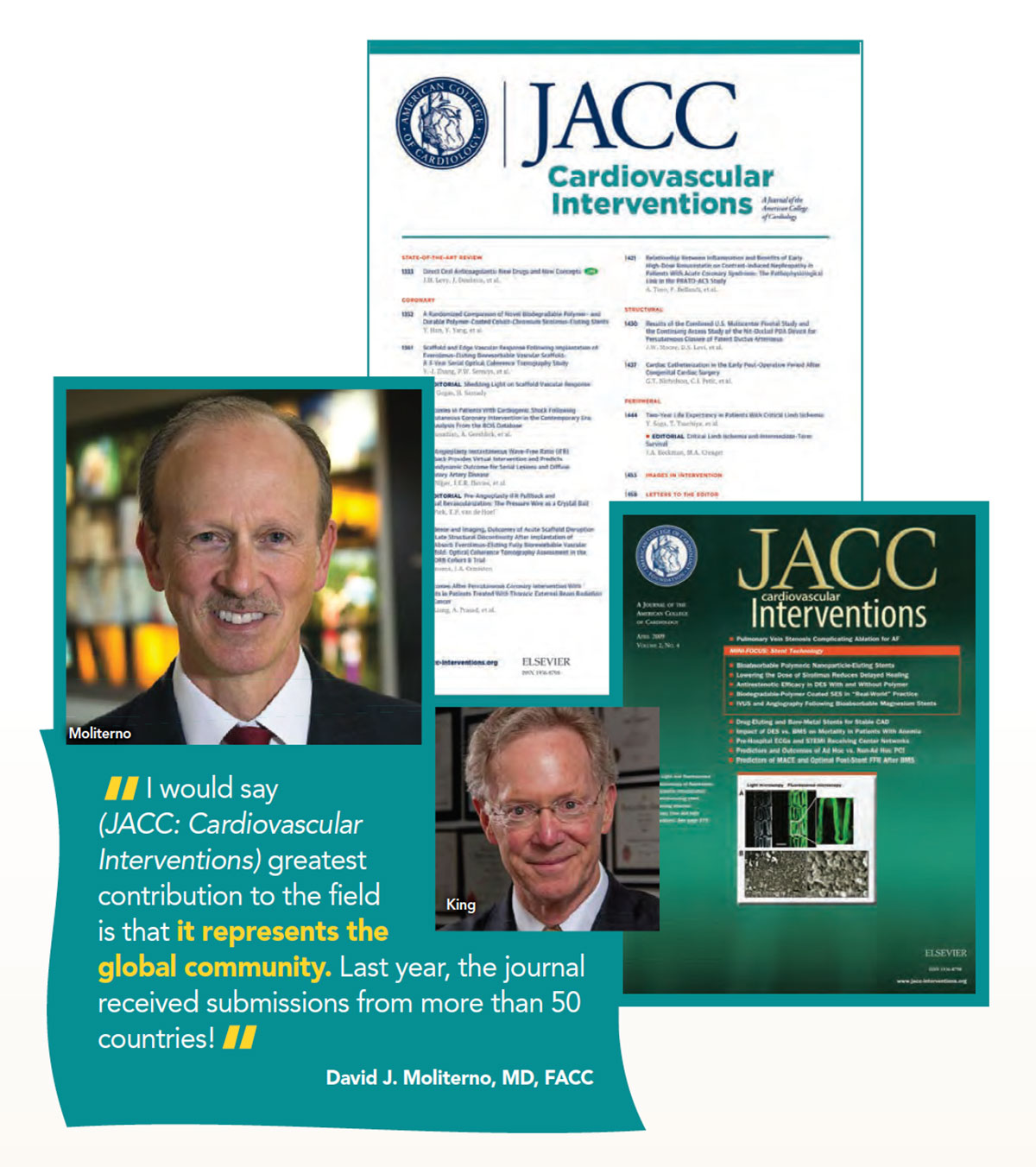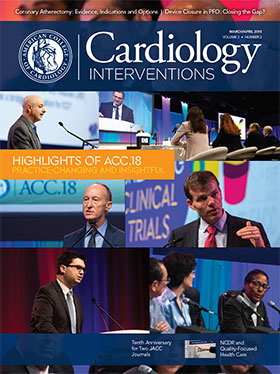Feature | Tenth Anniversary for Two JACC Journals
This spring, JACC: Cardiovascular Imaging and JACC: Cardiovascular Interventions are celebrating a decade of notable contributions to clinical cardiology. They are the second and third journals to be launched in the family of six JACC journals.
Focused on publishing the top research in their respective fields, the journals have served as important platforms for practice-changing research over the past decade. Publishing hundreds of manuscripts during this time, each journal has evolved to reflect changes within their fields and contributed to the upward trajectory of knowledge surrounding their specialties.
Cardiology: Interventions talked with JACC: Cardiovascular Imaging Editor-in-Chief Y. Chandrashekhar, MD, FACC, and JACC: Cardiovascular Interventions Editor-in-Chief David J. Moliterno, MD, FACC, about the contributions of their journals along with what they see ahead in their fields and the continued role of the journals.

Dr. Chandrashekhar, what are the journal’s greatest contributions to the field of cardiovascular imaging?
JACC: Cardiovascular Imaging, at its very inception, had promised to provide a robust and highly regarded platform for showcasing the art and science of imaging. Many would agree that it has fulfilled this promise in large measure. Through its unique multi-modality focus, fostered under the exceptional leadership of former Editor-in-Chief Jagat Narula, MD, PhD, MACC, the journal helped augment independent thinking about the modality at a time when most imaging research was published in single modality-centered vehicles. Finally, JACC: Cardiovascular Imaging has tried to encourage more evidence-based research in imaging and this has been enthusiastically supported by our audience.
What have been the most pivotal studies covered over the last 10 years?
In the last decade, we’ve published some of the most influential papers in interventional imaging – both assessing suitability of intervention and helping with its performance. Our journal published most of the major papers that address differentiating normal from abnormal myocardium in a number of conditions along with papers where this was used to predict prognosis in these conditions. Some robust imaging clinical trials found a home at JACC: Cardiovascular Imaging, particularly in the last few years. Since there are so few clinical trials in imaging, we’re very heartened that authors chose our journal to showcase these findings. We’ve published pioneering papers of work relating abnormal coronary flow (fractional flow reserve) to not only stenosis but to composition of the coronary plaque underlying the stenosis. Similarly, we published some of the first high impact papers relating systemic inflammation to cardiac disease progression and outcomes. Traditionally, review articles generate many more citations than original research; however, reviews accounted for less than 10 percent of the top cited papers in JACC: Cardiovascular Imaging over the last five years. It is gratifying to us that our original research is so highly appreciated by other investigators.
What makes JACC: Cardiovascular Imaging unique from other imaging publications?
All journals have a distinctive character and our journal has some unique flavors too. JACC: Cardiovascular Imaging has always been dedicated to publishing the highest quality original research — it has never encouraged small studies, those not performed robustly or case reports. It has been modality agnostic and it has not been averse to publishing important negative studies. And we encourage all good papers even from areas not traditionally considered covered under the usual “cardiac imaging” rubric. Our editors comprise top researchers in all modalities of imaging and more importantly they are based across many continents. This international diversity is also reflected in our publication profile with a healthy mix of authors from the U.S. and those from other countries.
What role would you like JACC: Cardiovascular Imaging to play in the imaging arena going forward?
Imaging is a field where the saying “a picture is worth a thousand words” is most apt. Moreover, most of what we do in imaging is finding information in moving images. Both finding information and best displaying it are far better suited to the “online world” rather than a static print or PDF page. The second decade of your favorite journal will be online only. There will be an option to “print on demand.” But, you’ll have the best visual and learning experience on our website! This move will come with a better experience designed specifically with the user in mind. Searching will be enhanced along with improvements for better learning opportunities for our readers. The web offers far greater potential for learning and sharing knowledge in imaging than print ever could allow. I’m excited about what this means for both our expert authors and discerning readers. Please stay tuned and do write to us about what you like or don’t like about our new avatar and other features you would like to see.
Looking ahead, what do you think will be the hottest topics in cardiovascular imaging 10 years from now?
Editors are not good at predicting the hottest topics in the next year or two, let alone 10 years from now! Some things, however, seem logical — better technology, miniaturization, faster imaging, better resolution and possibly better interfacing between multiple imaging modalities. Some things will remain the same — optimizing the economics of imaging will still be a hot topic. There’ll be pressure to show robust evidence that imaging makes a difference to patient outcomes and that we’ve imaged in the most efficient way. Predicting trends or trying to ride such waves is, however, a losing game for editors. We’ll continue to do what we have always done: meticulously encourage, curate and showcase the best papers that will change the practice of imaging.

Dr. Moliterno, what are the greatest contributions of JACC: Cardiovascular Interventions to the field of interventional cardiology as it celebrates its 10th anniversary?
Like many aspects of cardiology, the interventional field is continually changing. JACC: Cardiovascular Interventions has markedly helped the community to keep up with these advancements. Among the subspecialty journals in interventional cardiology, JACC: Cardiovascular Interventions was one of the first to be established. During his 10 years at the helm of the journal, Spencer B. King III, MD, MACC, did a terrific job keeping the journal on an upward trajectory. The journal quickly grew and moved from publishing several times per year to publishing twice a month. I would say its greatest contribution to the field is that it represents the global community. Last year, the journal received submissions from more than 50 countries!
What are you most proud of as you lead this journal?
When the deputy editors and I put together the working group of associate editors, we were focused on being inclusive. We brought together 30 partners from around the world representing all aspects of interventional cardiology. Likewise, we were fortunate to attract a group of outstanding editorial board consultants from North America, South America, Europe, Asia and the Middle East. We intentionally sought out female interventional cardiologists as they continue to be underrepresented in the field.
Looking ahead, what do you think will be the hottest interventional topics 10 years from now?
Over the past decade, there has been movement in the percentage of papers received in the categories of coronary, structural and peripheral interventions. The overwhelming predominance of papers early on was in coronary artery interventions. With the remarkable growth in structural heart disease, largely driven by transcatheter heart valves, a greater percentage of papers are now received in structural interventions. As I have said before, if you want to see where you are heading, look at the momentum that is carrying you. Clearly, JACC: Cardiovascular Interventions and the field will continue to grow with structural interventions. With a far greater prevalence of mitral and tricuspid valve disease among our patients, I expect that research, clinical care and publications for these valvular procedures will be the hottest topics over the coming several years.
What role would you like JACC: Cardiovascular Interventions to play in the interventional arena going forward?
Publications will continue to evolve as technology and the readership changes. The ongoing evolution in digital media and a variety of formats will continue and may accelerate. Just as JACC: Cardiovascular Interventions has been a pioneer in the interventional publication arena, so too would I like to see it become a valuable digital media pioneer going forward. We will continue to be a global journal. Digital media options will be essential for our readership.
Visit JACC.org to read the latest issue of JACC: Cardiovascular Imaging and JACC: Cardiovascular Interventions and all the journals in the JACC family.
Keywords: ACC Publications, Cardiology Interventions, Research Personnel, Coronary Vessels, Consultants, Leadership, Constriction, Pathologic, Prevalence, Tricuspid Valve, Cardiac Imaging Techniques, Research, Heart Diseases, Myocardium, Prognosis, Disease Progression, Inflammation
< Back to Listings

